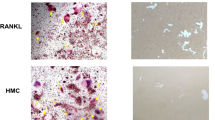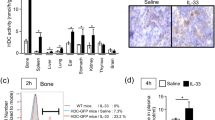Abstract
Using mouse peritoneal mast cells, we investigated the effects of 1α,25-dihydroxyvitamin D3 (calcitriol) on mast cell proliferation and histamine release. Calcitriol did not affect IL-3/IL-4-dependent mast cell proliferation, but it selectively inhibited stem cell factor-dependent mast cell proliferation and colony formation. Immunohistochemical and immunoblot analyses revealed that calcitriol treatment reduced expression of purified peritoneal mast cell c-kit protein. Using a mast cell line, MC/9, both c-kit protein and c-kit mRNA transcript were seen to be reduced following calcitriol treatment. Calcitriol also reduced histamine release induced by calcium ionophore A23187. In contrast, anti-IgE antibody-dependent histamine release was not affected by calcitriol. Our results indicate that calcitriol inhibits mast cell proliferation and A23187-induced histamine release that might be associated with a decreased expression of c-kit receptor.
Similar content being viewed by others
References
Toyota N, Kitamura Y, Ogawa K (1990) Administration of 8-methoxypsolaren and ultraviolet A irradiation (PUVA) induces turnover of mast cells in the skin of C57BL/6 mice. J Invest Dermatol 95:353–358
Toyota N, Hashimoto Y, Matsuo S, Izuka H (1995) Transforming growth factor β 1 inhibits IL-3 and IL-4-dependent mouse connective tissue-type mast cell proliferation. Arch Dermatol Res 287:198–201
Toyota N, Hashimoto Y, Matsuo S, Kitamura Y, Iizuka H (1996) Effects of FK506 and cyclosporin A on proliferation, histamine release and phenotype of murine mast cells. Arch Dermatol Res
Bienenstock J, Befus AD, Pearse F, Denburg J, Goodacre R (1982) Mast cell heterogeneity: derivation and function, with emphasis on the intestine. J Allergy Clin Immunol 70:407–412
Galli SJ, Dvorak AM, Dvorak HF (1984) Basophil and mast cell: morphologic insights into their biology, secretory patterns, and function. Prog Allergy 34:1–141
Tsuji K, Nakahata T, Takagi M, Kobayashi T, Ishiguro A, Kikuchi T, Naganuma K, Koike K, Miyajima A, Arai K, Akabane T (1990) Effects of interleukin-3 and interleukin-4 on the development of “connective-tissue type” mast cells: interleukin-3 supports their survival and interleukin-4 triggers and support their proliferation synergistically with interleukin-3. Blood 75:421–427
Hamaguchi Y, Kanakura Y, Fujita J, Takeda S, Nakano T, Tarui S, Honjo T, Kitamura Y (1987) Interleukin 4 as an essential factor for in vitro clonal growth of murine connective tissuetype mast cells. J Exp Med 165:268–273
Nabel GS, Galli J, Dvorak AM, Dvorak HF, Cantor H (1981) Inducer T lymphocytes synthesize a factor that stimulates proliferation of cloned mast cells. Nature 291:332–334
Thompson-Snipes L, Dhar V, Bond MW, Mosmann TR, Moore KW, Rennick DM (1991) Interleukin 10: A novel stimulatory factor for mast cells and progenitors. J Exp Med 173:507–510
Hültner L, Druez C, Moeller J, Uyttenhove C, Schmitt E, Rude E, Dormer P, Van Snick J (1990) Mast cell growth enhancing activity (MEA) is a structurally related and functionally identical to p40/TCGF III (interleukin 9). Eur J Immunol 20:1413–1416
Zsebo KM, Williams DA, Geissler EN, Broudy VC, Martin FH, Atkins HL, Hsu R-Y, Birkett NC, Okino KH, Murdock DC, Jacobsen FW, Langley KE, Smith KA, Takeishi T, Cattanach BM, Galli SJ, Suggs SV (1990) Stem cell factor is encoded at the SL locus of the mouse and is the ligand for the c-kit tyrosine kinase receptor. Cell 63:213–224
Besmer P, Murphy JE, George PC, Qiu F, Bergold PJ, Lederman L, Snyder HW, Brodeur D, Zukkerman EE, Hardy WD (1986) A new acute transforming feline retrovirus and relationship of its oncogene v-kit with the protein kinase gene family. Nature 320:415–421
Qiu F, Ray P, Brown K, Barker PE, Jhanwar S, Ruddle FH, Besmer P (1988) Primary structure of c-kit: relationship with the CSF-1/PDGF receptor kinase family-oncogenic activation of v-kit involves deletion of extracellular domain and C terminus. EMBO J 7:1003–1011
Kuroki T (1985) Possible functions of 1,25-dihydroxyvitamin D3, an active form of vitamin D3, in the differentiation and development of skin. J Invest Dermatol 84:459–460
Smith EL, Walworth NC, Holick MF (1986) Effect of 1α,25-dihydroxyvitamin D3 on the morphologic and biochemical differentiation of cultured human epidermal keratinocytes grown in serum-free conditions. J Invest Dermatol 86:709–714
Hosomi J, Hosoi J, Abe E, Suda T, Kuroki T (1983) Regulation of terminal differentiation of cultured mouse epidermal cells by 1α,25-dihydroxyvitamin D3. Endocrinology 113:1950–1957
Itin PH, Pittelkow MR, Kumar R (1994) Effects of vitamin D metabolites on proliferation and differentiation of cultured human epidermal keratinocytes grown in serum-free or defined culture medium. Endocrinology 135:1793–1798
Pike JW (1991) Vitamin D3 receptors: structure and function in transcription. Annu Rev Nutr 11:189–216
Nakahata T, Ogawa M (1982) Identification in culture of a class of hematopoietic colony-forming units with extensive capacity to self-renew and generate multipotential hematopoietic colonies. Proc Natl Acad Sci USA 79:3843–3847
Tsuji K, Zsebo KM, Ogawa M (1991) Murne mast cell colony formation supported by IL-3, IL-4, and recombinant rat stem cell factor, ligand for c-kit. J Cell Physiol 148:362–369
Ogawa M, Matsuzaki Y, Nishikawa S, Hayashi S, Kunusada T, Nakauchi H, Nishikawa S (1991) Expression and function of c-kit in hemopoietic progenitor cells. J Exp Med 174:63–71
Nishikawa S, Kusakabe M, Yoshinaga K, Ogawa M, Hayashi S, Kunusada T, Era T, Sakakura T, Nishikawa S (1991) In utero manipulation of coat color formation by a monoclonal anti-c-kit antibody: two distinct waves of c-kit dependency during melanocyte development. EMBO J 10:2111–2118
Laemmli UK (1970) Cleavage of structural proteins during the assembly of the head of bacteriophage T4. Nature 227:680–685
Maniatis T, Fritsch EF, Sambrook T (1989) Molecular cloning: a laboratory manual, 2nd edn. Cold Spring Harbor Laboratory, Cold Spring Harbor, NY
Thomas PS (1980) Hybridization of denatured RNA and small DNA fragments transferred to nitrocellulose. Proc Natl Acad Sci USA 77:5201–5205
Saito H, Okajima F, Moki TFP, Sha’afi RI, Ui M (1988) Effect of cholera toxin on histamine release from bone marrow-derived mouse mast cells. Proc Natl Acad Sci USA 85: 2504–2508
Pearce FL (1982) Calcium and histamine secretion from mast cells. Prog Med Chem 19:59–109
Caroni P, Gazzotti P, Vuilleumier P, Simon W, Carafori E (1977) Ca2+ transport mediated by synthetic neutral Ca2+-ionophore in biological membranes. Biochimica Biophys Acta 470: 437–445
Matsue H, Cruz PD Jr, Bergstresser PR, Takashima A (1992) Cytokine expression by epidermal subpopulations. J Invest Dermatol 99:42S-45S
Plaut M, Pierce JH, Watson CJ, Hanley-Hyde J, Nordan RP Paul WE (1989) Mast cell lines produce lymphokines in response to cross-linkage of Fc epsilon or to calcium ionophores. Nature 339:64–67
Brown MA, Pierce JH, Watson CJ, Falco J, Ihle JN, Paul WE (1987) B cell stimulatory factor-1/interleukin-4 mRNA is expressed by normal and transformed mast cells. Cell 50:807–818
Galli SJ, Tsai M, Wershil BK (1993) The c-kit receptor, stem cell factor, and mast cells: what each is teaching us about the other. Am J Pathol 142:965–974
Grabbe J, Welker P, Dippel B, Crarnetzki BM (1994) Stem cell factor, a novel cutaneous growt factor for mast cells and melanocytes. Arch Dermatol Res 287:78–84
Fujita J, Nakayama H, Onoue H, Kanakura Y, Nakano T, Asai H, Takeda S, Honjo T, Kitamura Y (1988) Fibroblast-dependent growth of mouse mast cells in vitro: duplication of mast cell depletion in mutant mice of W/Wv genotype. J Cell Physiol 134:78–84
Keller R, Hess MW, Riley JF (1976) Mast cells in the skin or normal, hairless and athymic mice. Experientia 32:171–172
Koli K, Keski-Oja J (1993) Vitamin D3 and calcipotriol enhance the secretion of transforming growth factor-β1 and-β2 in cultured murine keratinocytes. Growth Factors 8:153–163
Koga M, Elisman JA, Sutherland RL (1988) Regulation of epidermal growth factor receptor levels by 1,25-dihydroxyvitamin D3 in human breast cancer cells. Cancer Res 48:2734–2739
Matsumoto K, Hashimoto K, Nishida Y, Hashiro M, Yoshikawa K (1990) Growth-inhibitory effects of 1,25-dihydroxyvitamin D3 on normal human keratinocytes cultured in serumfree medium. Biochem Biophys Res Commun 166:916–923
Pillai S, Bikle DD, Elias P (1988) 1,25-dihydroxyvitamin D production and receptor binding in human keratinocytes varies with differentiation. J Biol Chem 263:5390–5395
Bikle DD, Nemanic MK, Gee E, Elias P (1986) 1,25-dihydroxyvitamin D production by human keratinocyte. J Clin Invest 78:557–566
Inaba M, Burgos-Trinidad M, DeLÖuca HF (1991) Characteristics of the 25-dihydroxyvitamin D3 and 1,25-dihydroxyvitamin D3-24-hydroxylase(s) from HL-60 cells. Arch Biochem Biophys 284:257–263
Bittner B, Bleehen SS, MacNeil S (1991) I alpha, 25(OH)2 vitamin D3 increases intracellular calcium in human keratinocytes. Br J Dermatol 124:230–235
Hills SE, Bleehen SS, MacNeil S (1989) 1α,25-dihydroxyvitamin D3 increases intracellular free calcium in murine B16 melanoma. Br J Dermatol 120:21–30
Janiszewski J, Hizinga JD, Blennerhassett MG (1992) Mast cell ionic channels: significance for stimulus-secretion coupling. Can J Physiol Pharmacol 70:1–7
Zhang L, McCloskey MA (1995) Immunoglobulin E receptor-activated calcium conductance in rat mast cell. J Physiol 483: 59–66
Coleman JW, Holliday MR, Kimber I, Zsebo KM, Galli SJ (1993) Regulation of mouse peritoneal mast cell secretory function by stem cell factor, IL-3 or IL-4. J Immunol 150:556–562
Author information
Authors and Affiliations
Rights and permissions
About this article
Cite this article
Toyota, N., Sakai, H., Takahashi, H. et al. Inhibitory effect of 1α,25-dihydroxyvitamin D3 on mast cell proliferation and A23187-induced histamine release, also accompanied by a decreased c-kit receptor. Arch Dermatol Res 288, 709–715 (1996). https://doi.org/10.1007/BF02505282
Received:
Issue Date:
DOI: https://doi.org/10.1007/BF02505282




